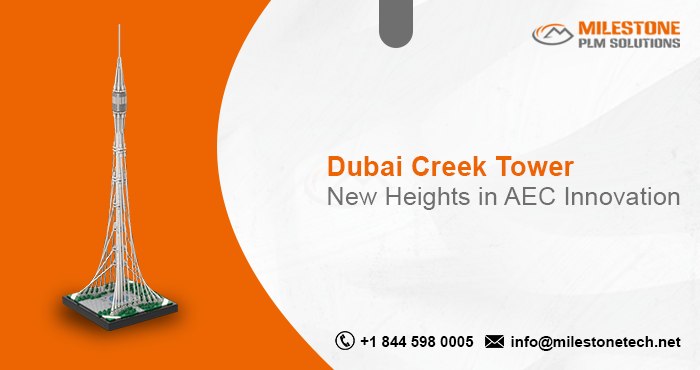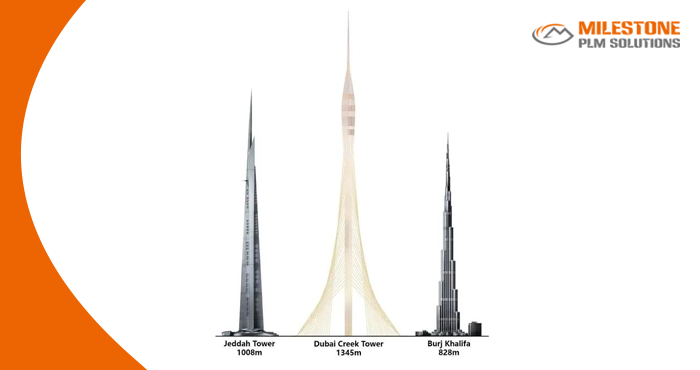Dubai Creek Tower: New Heights in AEC Innovation

The world of architecture, engineering, and construction never ceases to amaze with ambitious endeavors like Dubai Creek Tower. Aiming to surpass records and create an indelible landmark within the cityscape, It aspires to redefine what is possible through determination. Upon anticipated completion, this lofty spire will stand unmatched globally as the planet’s tallest tower, representing far more than an eye-catching structure; it symbolizes innovation, sustainability, and a testament to the boundless potential of modern engineering.
This article delves into the astounding nuances of Dubai Creek Tower, exploring its pivotal design and engineering aspects, juxtapositions with the Burj Khalifa, and projected impacts on the forever evolving AEC industry. Some of its striking features include wind-resistant construction and a desalination plant to help sustain local water needs. Towering above all else, It pushes boundaries with both architectural daring and consideration for the future.
A New Icon in the Skyline
Dubai Creek Tower, also referred to fondly as “The Marvel,” will tower ominously over Dubai Creek Harbour and break numerous records, surpassing the iconic Burj Khalifa more so in dramatic fashion. Conceived ambitiously by the pioneering developers at Emaar Properties and designed artfully by renowned architect Santiago Calatrava, this unprecedented structure signifies more than merely a skyscraper; it is a symbol of architectural daring and technological magic. With a projected height eclipsing a staggering 1,300 meters, It aims to snatch the title of the world’s supreme structure, leaving the impressive yet slightly less impressive Burj Khalifa’s 828 meters in its prodigious shadow.
Groundbreaking Design Inspired by Tradition
Santiago Calatrava took inspiration from the beautiful lily flower native to the region for his revolutionary design of Dubai Creek Tower. The main body of the monumental structure calls to mind the tall, graceful stem of a lily in bloom. Yet Calatrava’s genius vision blended the elegant symmetry of nature with the pinnacle of modern structural engineering principles. Like a lily’s root system that anchors deep in soil to nourish growth, the tower’s mighty foundation is set firmly in place, a testament to Dubai’s history and future strength. Additionally, the tower’s highest point resembles the minaret of a mosque, paying homage to Dubai’s Islamic heritage through symbolic design. Overall, Calatrava crafted a work of architecture that is both aesthetically striking and culturally resonant with the people of the UAE.
The architectural design is defined by several unique elements:
- Elongated Central Shaft: Unlike the multi-tiered structure of the Burj Khalifa, Dubai Creek Tower will feature an elongated, slender central core.
- Tension Cables: The tower will have a complex system of steel cables that extend from the structure to the ground, adding stability and aesthetic value. These cables also reflect the delicate balance between tradition and innovation in modern engineering.
- Observation Decks: The pinnacle of Dubai Creek Tower will host multiple observation decks, offering 360-degree views of Dubai and the surrounding landscape. These platforms are designed to provide an unparalleled viewing experience, making the tower a major tourist attraction.
Setting New Standards in AEC
It sets a new benchmark in AEC with its groundbreaking design and engineering approaches. Here are some key points illustrating the tower’s impact on the AEC industry:
Advanced Materials and Techniques
The tower’s structure will utilize state-of-the-art materials, including high-performance concrete, designed to withstand extreme weather conditions. Innovations in construction methods, such as modular and prefabricated components, will also contribute to the efficient and safe erection of the tower.
Wind and Earthquake Resistance
One of the primary engineering challenges of Dubai Creek Tower involves ensuring stability at unprecedented heights. The complex system of cables and the central core work together to provide stability against wind forces and seismic activity, essential in a region like Dubai, known for its harsh weather conditions.
Energy Efficiency and Sustainability
Dubai Creek Tower places a strong emphasis on sustainability, incorporating various energy-efficient systems to minimize its environmental footprint. Advanced HVAC systems, smart lighting, and energy management solutions are part of the tower’s design to achieve a sustainable operation. Additionally, materials used in construction are selected to meet global environmental standards.
Comparing Dubai Creek Tower and Burj Khalifa
While Dubai Creek Tower and Burj Khalifa are both iconic landmarks, their design philosophies, structural systems, and purposes differ significantly.
| Feature | Burj Khalifa | Dubai Creek Tower |
| Height | 828 meters | Projected over 1,300 meters |
| Design | Multi-tiered, layered | Single slender shaft with cable support |
| Architect | Adrian Smith | Santiago Calatrava |
| Completion Date | 2010 | Expected by 2025 |
| Primary Function | Mixed-use (residential, hotel, office) | Observation and tourism |
| Innovation Focus | Structural height, luxury spaces | Stability, observation decks, sustainable materials |
While Burj Khalifa serves as a multi-functional skyscraper, Dubai Creek Tower is envisioned primarily as a cultural and tourist landmark with emphasis on observation and architectural innovation.

A Timeline of Vision and Execution
The journey of Dubai Creek Tower commenced in 2016, when design and development initially began taking shape. On October 10th of that year, a momentous groundbreaking ceremony kicked off the beginning of construction in earnest. Originally, completion was eyed for 2020 to coincide with Dubai’s hosting of the Expo 2020 world’s fair. However, unforeseen complications, such as those brought forth by the unpredicted COVID-19 pandemic, demanded the deadline be postponed. As of now, projections anticipate Dubai Creek Tower will attain finalization by 2025 following several phases of meticulous building and rigorous testing done in bursts with varying intricacy.
Impacts on Dubai and the Global AEC Industry
Dubai Creek Tower will dramatically transform Dubai, boosting its status as a global hub for tourism, business, and innovation like never before. By setting an unprecedented benchmark in structural resilience, sustainability, and architectural beauty through cutting-edge design, this record-breaking tower is certain to inspire awe and shape the future of skyscraper construction globally. Moreover, Dubai Creek Harbour, the area surrounding the tower, will be cultivated into a vibrant mixed-use community featuring spacious residential quarters, bustling commercial centers, and abundant recreational parklands, magnifying Dubai’s alluring economic and cultural magnetism.
From a worldwide perspective, Dubai Creek Tower signifies a unprecedented feat in pushing the boundaries of design and engineering to their limits. By prioritizing stability through groundbreaking systems, harnessing advanced materials never seen before, and pioneering new standards in environmental stewardship, the tower reflects the constant evolution of skyscraper innovation and the progressive spirit of the AEC industry.
Technological Innovations and Construction Milestones
Several technological innovations have contributed to the tower’s progress. These include:
- BIM Integration: Building Information Modeling (BIM) has played a significant role in the planning and execution of Dubai Creek Tower. BIM enables real-time collaboration between architects, engineers, and contractors, ensuring precision and accuracy during construction.
- Robotics and Automation: Automation has been employed in various stages of construction, from material handling to quality control, ensuring that the tower is built with the highest standards of safety and efficiency.
- Digital Twins: A digital twin of the Dubai Creek Tower allows engineers to simulate and test various scenarios, providing insights into the tower’s performance under different environmental conditions. This innovation is crucial for a structure of this scale and complexity.
The Future of Skyscraper Engineering
Dubai Creek Tower stands as a towering testament to the limitless prospects within architecture, engineering, and construction. As high-rises progress ever upwards, reliance on eco-friendly techniques combined with avant-garde concepts and cutting-edge tools is ever more crucial. In myriad nuanced ways, Dubai Creek Tower embodies the coming ages of loftily lifting reinforced concrete: daringly aspiring, conscientiously preserving, resonantly rooted in both ancestral importance and mechanistic evolution.
Conclusion
Dubai Creek Tower seeks not merely to tower above all else but to stand as a representation of mankind’s inventiveness, architectural gifts, and cultural creativity. Upon finalizing construction, it will serve as evidence of Dubai’s unrelenting dedication to quality and novel advancement in the field of architecture, engineering, and construction. Whether functioning as a wellspring of motivation or a prime example of testing engineering’s limits, Dubai Creek Tower is unquestionably forging new frontiers for innovation within architecture, engineering, and construction. Its colossal stature displays an impressive technical feat while also embodying the vibrant spirit of the city it has been designed and built to enrich.
Yes, the Dubai Creek Tower is expected to be completed in 2025. However, construction is currently on pause while the project is being redesigned. New details are expected to be announced in April 2024, with construction set to resume in August 2024.
No, the Dubai Creek Tower is not bigger than the Burj Khalifa. In February 2024, it was announced that the tower’s height would be reduced so that it would be shorter than the Burj Khalifa. Construction restarted in March 2024, and the final design was expected to be unveiled in April 2024
Emaar Properties owns the Dubai Creek Tower.The Dubai Creek Tower is a skyscraper in the Dubai Creek Harbour area. It was originally planned to be the tallest building in Dubai, but the developer has since decided to design it as a “female” counterpart to the Burj Khalifa.
No, the Jeddah Tower will be taller than the Dubai Creek Tower.This skyscraper in Dubai, United Arab Emirates is expected to be between 928 meters and 1,400 meters tall. It will feature a 360-degree observation deck, hotels, restaurants, and residences.
Follow Milestone PLM Solutions for Mechanical Industry Updates, CAD Tips and Global Mechanical News.
Milestone PLM Solutions with its exclusive delivery center in India is a global CAD, CAM & FEA services outsourcing partner serving the needs of the Mechanical, Millwork and Automotive industry since 2004. MILESTONE focuses on the unique needs of clients and believes in tackling real-life problems with efficiency, smooth and ease.
The MILESTONE team can assist you with Product Design, 3d Modeling, Drafting & detailing, Reverse Engineering, FEA Analysis and more. We support multiple software including AutoCAD, SolidWorks, Catia, NX, Inventor, Solidedge & Ansys etc. Our approach is to provide a dedicated team for each customer over ongoing project and deliver the quality output consistently.
With our state of art technology and large talent pool of Engineers, we are developing best in class solutions for our customers across the globe. We align with your culture and values to form unbreakable partnerships and are primed for success with over 100 employees and 150 customers in the US, Europe, India, and Asia.
You can email us at info@milestonetech.net and can log in to our website www. milestonetech.net to know more about our services and our work portfolio or contact us on +1-844-598-0005
